This is a community wiki essentially copying user teunbrand's canonical answer to that topic - for more visibility added to this larger thread.
Consider the following plot (geom_col() is equivalent to geom_bar(stat = "identity")):
df <- data.frame(x = letters[1:7],
y = 1:7)
g <- ggplot(df, aes(x, y)) +
geom_col()
g

You can clearly see that the bars look like rectangles. Checking the underlying plot data, confirms that the bars are parameterised as rectangles with xmin/xmax/ymin/ymax parametrisation:
> layer_data(g)
x y PANEL group ymin ymax xmin xmax colour fill size linetype alpha
1 1 1 1 1 0 1 0.55 1.45 NA grey35 0.5 1 NA
2 2 2 1 2 0 2 1.55 2.45 NA grey35 0.5 1 NA
3 3 3 1 3 0 3 2.55 3.45 NA grey35 0.5 1 NA
4 4 4 1 4 0 4 3.55 4.45 NA grey35 0.5 1 NA
5 5 5 1 5 0 5 4.55 5.45 NA grey35 0.5 1 NA
6 6 6 1 6 0 6 5.55 6.45 NA grey35 0.5 1 NA
7 7 7 1 7 0 7 6.55 7.45 NA grey35 0.5 1 NA
Now consider the following plot:
g2 <- ggplot(df, aes(x, y)) +
geom_col() +
scale_y_continuous(limits = c(1, 7))

This one is empty, and reflects the case you have posted. Inspecting the underlying data yields the following:
> layer_data(g2)
y x PANEL group ymin ymax xmin xmax colour fill size linetype alpha
1 1 1 1 1 NA 1 0.55 1.45 NA grey35 0.5 1 NA
2 2 2 1 2 NA 2 1.55 2.45 NA grey35 0.5 1 NA
3 3 3 1 3 NA 3 2.55 3.45 NA grey35 0.5 1 NA
4 4 4 1 4 NA 4 3.55 4.45 NA grey35 0.5 1 NA
5 5 5 1 5 NA 5 4.55 5.45 NA grey35 0.5 1 NA
6 6 6 1 6 NA 6 5.55 6.45 NA grey35 0.5 1 NA
7 7 7 1 7 NA 7 6.55 7.45 NA grey35 0.5 1 NA
You can see that the ymin column is replaced by NAs. This behaviour depends on the oob (out-of-bounds) argument of scale_y_continuous(), which defaults to the scales::censor() function. This censors (replaces with NA) any values that are outside the axis limits, which includes the 0 which should be the ymin column. As a consequence, the rectangles can't be drawn.
There are two ways to work around this. One candidate is indeed as Magnus suggested to use the ylim argument in the coord_cartesian() function:
ggplot(df, aes(x, y)) +
geom_col() +
coord_cartesian(ylim = c(1, 7))

Specifying the limits inside a coord_* function causes the graphical objects to be clipped. You can see this in action when you turn the clipping off:
ggplot(df, aes(x, y)) +
geom_col() +
coord_cartesian(ylim = c(1, 7), clip = "off")

The other option is to use an alternative oob argument in the scale_y_continuous, for example scales::squish:
g3 <- ggplot(df, aes(x, y)) +
geom_col() +
scale_y_continuous(limits = c(1, 7),
oob = scales::squish)
g3

What this does, is that it replaces any value outside the limits by the nearest limit, e.g. the ymin of 0 becomes 1:
> layer_data(g3)
y x PANEL group ymin ymax xmin xmax colour fill size linetype alpha
1 1 1 1 1 1 1 0.55 1.45 NA grey35 0.5 1 NA
2 2 2 1 2 1 2 1.55 2.45 NA grey35 0.5 1 NA
3 3 3 1 3 1 3 2.55 3.45 NA grey35 0.5 1 NA
4 4 4 1 4 1 4 3.55 4.45 NA grey35 0.5 1 NA
5 5 5 1 5 1 5 4.55 5.45 NA grey35 0.5 1 NA
6 6 6 1 6 1 6 5.55 6.45 NA grey35 0.5 1 NA
7 7 7 1 7 1 7 6.55 7.45 NA grey35 0.5 1 NA
Another thing you could do is provide a custom function to the oob argument, that simply returns it's input. Since by default, clipping is on, this reflects the coord_cartesian(ylim = c(1,7)) case:
ggplot(df, aes(x, y)) +
geom_col() +
scale_y_continuous(limits = c(1, 7),
oob = function(x, ...){x})





